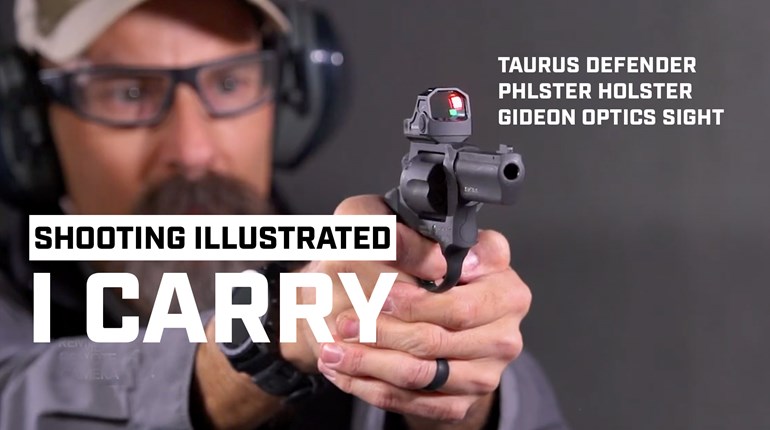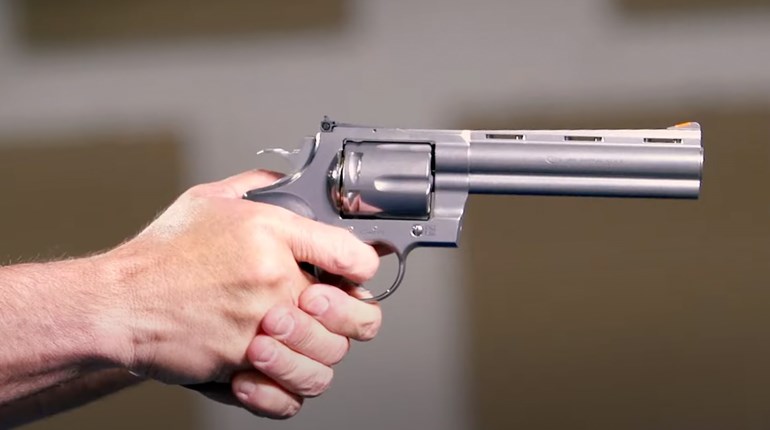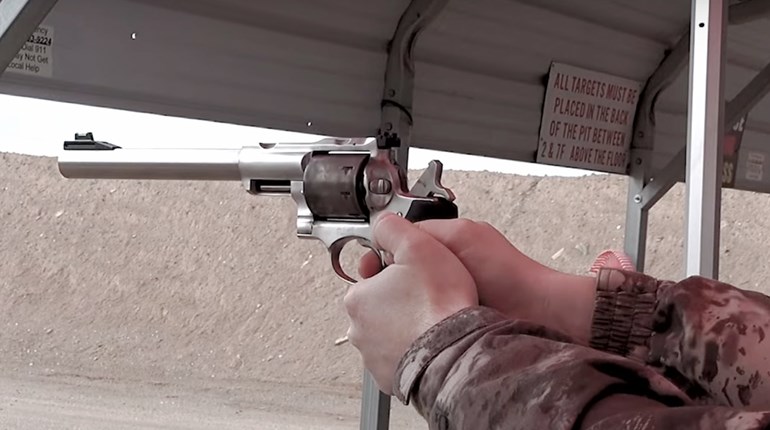
Cute is exactly the descriptive adjective that comes to mind when viewing the Smith & Wesson Model 36 (although this was probably not the specific handgun to which the former First Lady was referring).
With its stubby 1 7⁄8-inch barrel, compact five-shot cylinder and rounded butt, this little pocket pistol tips the scales right around 20 ounces. Even so, I doubt the tens of thousands of law enforcement officers and civilians who have packed this diminutive but rugged revolver would call it cute. Certainly not Jack Webb, who, as Sergeant Joe Friday, flashed his Chiefs Special with authority on the old "Dragnet" television series. Or Gene Hackman, as Detective Jimmy "Popeye" Doyle, who swapped his Colt Detective Special in "The French Connection" for a Model 36 in the "French Connection II" sequel. But it isn't just Hollywood that has been attracted to the Model 36—in real life this little revolver is a lawman's handgun, and rightfully so, for it was named by a room full of police chiefs.
In 1948, Smith & Wesson President C.R. Hellstrom realized there was a need for a snub-nosed revolver, similar in size to the company's Terrier, but revamped to handle the more powerful .38 Spl. The Terrier was built on a .32-caliber frame but was chambered for the .38 S&W cartridge—a short-range, relatively anemic round that originated with Smith & Wesson's top-breaks in 1877. The new revolver Hellstrom envisioned would have to retain the Terrier's compactness, but be able to handle the more popular .38 Spl., a favorite with lawmen of that era. In fact, it was the rival Colt Detective Special, specifically in its .38 Spl. chambering, that was the impetus for Hellstrom's new revolver.
Smith & Wesson's engineers went to work, using the Terrier as a jumping-off point. They beefed up the gun by lengthening and strengthening the cylinder and frame (thus making it a true .38 size), while retaining the cylinder's five-shot capacity. In addition, the Terrier's flat mainspring was replaced with a sturdier coil spring. As the Terrier was built on the slightly smaller I-frame, this newer revolver became the first of the J-frame series and carried its own set of serial numbers. But, as part of a very clever marketing plan, the gun was not given a name designation.
Having created the new revolver to appeal to off-duty policemen and plainclothes detectives, it was decided to let the decision makers among these potential purchasers select a name. The first gun, completed on Oct. 24, 1950, was unveiled that same month at the International Association of Chiefs of Police conference in Colorado Springs, CO. There, Smith & Wesson invited the assembled chiefs of police to suggest a name for the new revolver. Perhaps inspired by the already well-established Colt Detective Special, the overriding choice from the attendees was to call it the Chiefs Special.
The earliest guns were blued with a case-hardened hammer and trigger, or nickeled, and came with rounded, two-piece, checkered walnut grips. The front sight was a fixed, no-snag serrated ramp that ran the length of the barrel, while the rear sight was simply a groove milled into the topstrap. After all, this was a close-range pistol meant for fast shooting. Nonetheless, due to numerous requests, by the end of the first year the factory was also producing a version with a 3-inch barrel.
For anyone with small to medium-sized hands, the Chiefs Special was easy to grasp, point and shoot. However, there were obviously enough complaints from those with beefier hands, as a slightly less concealable square-butt version was introduced in 1952, starting with serial number 21,342.
In 1957, Smith & Wesson switched to a numerical system of identification, and the Chiefs Special became the Model 36, starting with serial number 125,000. It was also around this time that Vice President Richard M. Nixon was presented with an engraved Chiefs Special by the NRA.
Numerous minor external and internal changes have been made to the Chiefs Special over the years, including eliminating the front trigger guard screw in 1953 and changing the cylinder-unlocking thumb piece from a flat to a more contoured style in 1966. Perhaps the most dramatic change occurred in 1965, when a stainless steel version of the Model 36 was introduced, becoming the world's first stainless revolver. To differentiate it, Smith & Wesson called the stainless gun the Model 60.
Another notable variation of the Model 36 was a heavy-barreled, 3-inch version in 1967. And beginning in 1955, there were limited runs of 2- and 3-inch-barreled guns with adjustable target sights. (To make things confusing, these rarities—of which approximately 1,740 were produced—were listed as the Model 50 from 1965 through 1975.) Other versions include the Chiefs Special Airweight with an aluminum-alloy cylinder and frame (do not shoot these without having them factory-checked for safety beforehand), and the highly popular stainless steel Ladysmith. Still other offshoots of the basic Model 36 are the shrouded-hammer Model 49 Bodyguard and the hammerless Model 40 Centennial, with its famous grip safety.
Years ago I purchased a blued Model 36 for my wife. It easily fit her hand, and after some extended time at the range shooting Glaser self-defense loads and standard factory ammo (+P ammo should be avoided with these snubbies), she became uncannily proficient with it. In the meantime, I had fallen under the spell of that "cute little gun." So I went out and bought a Model 60 for myself. It would make an excellent "bathrobe gun" I rationalized, something unobtrusive to slip into my pocket while walking to the curb to pick up the morning paper.
The Model 60 and its variations have remained in the Smith & Wesson line, and although the original Model 36 was discontinued in 1999, it was brought back in 2008 as part of the company's Classics Series. It was a fitting return for a snub-nosed .38 that won the praise of law enforcement veterans from its very first day on the job.



































